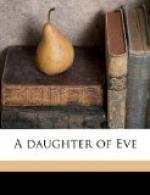“With a husband, my dear innocent, we live, as it were, in our own life; but to love, is to live in the life of another,” said the Marquise d’Espard.
“A lover is forbidden fruit, and that to me, says all!” cried the pretty Moina de Saint-Heren, laughing.
When she was not at some diplomatic rout, or at a ball given by rich foreigners, like Lady Dudley or the Princesse Galathionne, the Comtesse de Vandenesse might be seen, after the Opera, at the houses of Madame d’Espard, the Marquise de Listomere, Mademoiselle des Touches, the Comtesse de Montcornet, or the Vicomtesse de Grandlieu, the only aristocratic houses then open; and never did she leave any one of them without some evil seed of the world being sown in her heart. She heard talk of completing her life,—a saying much in fashion in those days; of being comprehended,—another word to which women gave strange meanings. She often returned home uneasy, excited, curious, and thoughtful. She began to find something less, she hardly knew what, in her life; but she did not yet go so far as to think it lonely.
CHAPTER IV
A celebrated man
The most amusing society, but also the most mixed, which Madame Felix de Vandenesse frequented, was that of the Comtesse de Montcornet, a charming little woman, who received illustrious artists, leading financial personages, distinguished writers; but only after subjecting them to so rigid an examination that the most exclusive aristocrat had nothing to fear in coming in contact with this second-class society. The loftiest pretensions were there respected.
During the winter of 1833, when society rallied after the revolution of July, some salons, notably those of Mesdames d’Espard and de Listomere, Mademoiselle des Touches, and the Duchesse de Grandlieu, had selected certain of the celebrities in art, science, literature, and politics, and received them. Society can lose nothing of its rights, and it must be amused. At a concert given by Madame de Montcornet toward the close of the winter of 1833, a man of rising fame in literature and politics appeared in her salon, brought there by one of the wittiest, but also one of the laziest writers of that epoch, Emile Blondet, celebrated behind closed doors, highly praised by journalists, but unknown beyond the barriers. Blondet himself was well aware of this; he indulged in no illusions, and, among his other witty and contemptuous sayings, he was wont to remark that fame is a poison good to take in little doses.
From the moment when the man we speak of, Raoul Nathan, after a long struggle, forced his way to the public gaze, he had put to profit the sudden infatuation for form manifested by those elegant descendants of the middle ages, jestingly called Young France. He assumed the singularities of a man of genius and enrolled himself among those adorers of art, whose intentions, let us say, were excellent; for surely nothing could be more ridiculous than the costume of Frenchmen in the nineteenth century, and nothing more courageous than an attempt to reform it. Raoul, let us do him this justice, presents in his person something fine, fantastic, and extraordinary, which needs a frame. His enemies, or his friends, they are about the same thing, agree that nothing could harmonize better with his mind than his outward form.




